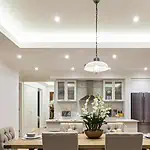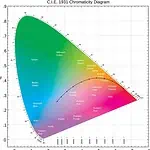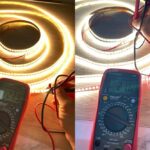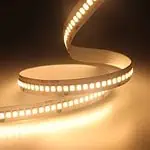There is a reason why experts do not recommend looking directly towards the sun. The glare coming from it can strain our eyes which not only impairs vision but also produces headaches. But it is not just the sun that can produce the glares; every light source has that potential, be it LEDs or traditional incandescent bulbs. Looking at either can produce the same symptoms as looking directly towards the sun, albeit less severe. Fortunately, the anti-glare lights offer a solution to it. And it is precisely what we will discuss in this piece. So, let’s get straight to it.
What is Glare and How Does It Impact Our Health?
Light plays a vital role in our vision. We can see objects only when light bounces off them and reaches our eyes. But our eyes can only withstand a certain intensity of light. When the intensity exceeds our limit, it impairs vision. And that light that impairs our vision is known as glare. It is the same phenomenon we experience if a car coming towards us has a high beam pointed directly towards us.
Furthermore, even if the light source is not pointed directly towards us, it can produce glare. It can reflect off another object and come in contact with our eyes. Glares can strain everybody’s eyes, but it is more severe in people with impaired eyesight. Experiencing glare for a long time can cause significant discomfort. It can trigger migraines in susceptible individuals and produce headaches and even nausea in some people.
Hence, avoiding glare from all lights, whether in homes or offices, is essential.
How Do You Measure The LED Glare?
The intensity of light that can produce glare varies in different environments. The ambience lighting creates a crucial role in determining what constitutes a glare. Our eyes can adapt to the ambient environment after some time. Hence, when the ambient lights are brighter, the intensity required to produce glare will be higher. On the other hand, if the ambient lights are on the darker side of the spectrum, the rays from computer screens would be enough to produce glare.
Furthermore, different areas in homes and offices have varying lighting needs. So, you cannot just select one type of LED in all portions. You must select an LED that provides enough lumens to ensure utility while not being too bright to produce glares. Fortunately, it is not that difficult because of UGR or Unified Glare Ratings, based on European Standards. It enlists the UGR with appropriate applications.
LEDs with a UGR of less than 19 suit applications like writing, reading and other office-based works. In warehouses and technical drawing rooms, LEDs with a UGR of less than 16 work the best. And anything below 14 will work for the general home lighting. Lights with a UGR of more than 30 produce high-intensity glares in every lighting environment. However, remember that UGR works only when selecting the lights for indoor conditions. It is the measure of the relative difference between the ambient lighting and the brightness of LED that suits a particular environment.
What is an Anti-Glare Light?
Anti-Glare is a special light designed for people sensitive to bright lights. Such lights produce gentle lighting, which is easy on the eyes and does not produce any strain. Your eyes take much less time to adjust to such an environment, making reading and writing easier. Furthermore, it does not come at the expense of luminosity and ensures optimal utility.
Such lights are ideal for individuals that have limited exposure to direct sunlight. People that stay indoors would find anti-glare lights very beneficial. You can use these lights in living rooms and bedrooms to read, write and watch TV. When these lights are on while watching TV or working on a laptop, they reduce the strain on your eyes. Hence, you can improve productivity and entertain yourself without feeling fatigued.
Anti-glare lights eliminate the need for brighter LEDs that produce more glare. You get optimal lighting conditions without risking the health of your eyes with these lights.
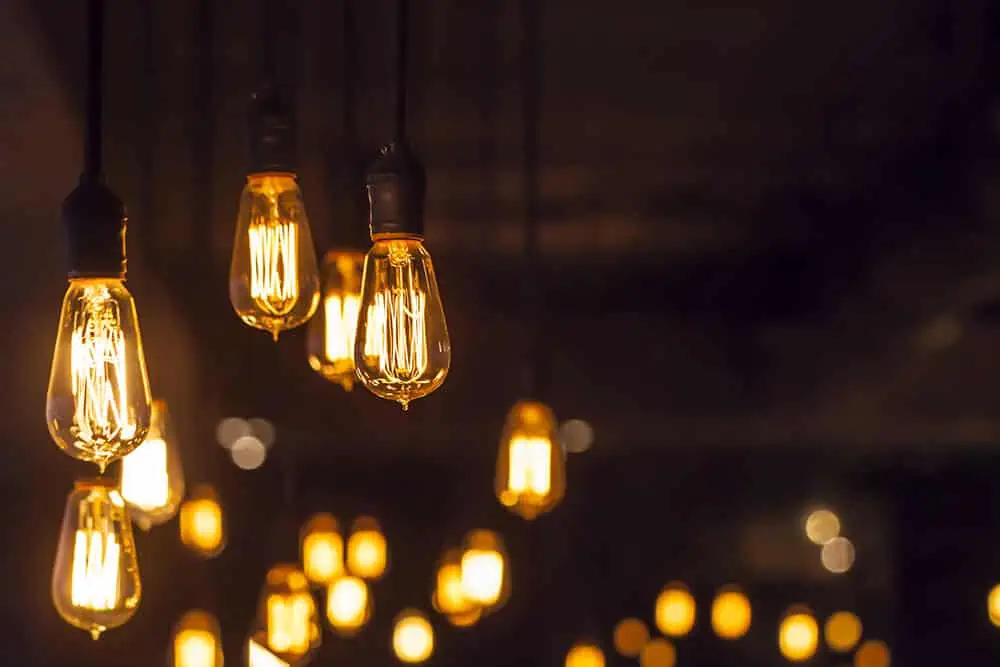
How Do Anti-Glare Lights Work?
Companies use different technology to produce anti-glare LED lights. Some of them employ prismatic diffusers, while others use anti-glare films. The fundamental purpose of all technologies is to reduce the glare coming from the direct source.
How to Check Whether a LED is Anti-Glare?
Anti-glare LEDs typically have micro-prismatic technology. It works as a diffuser and distributes the light evenly. The homogenous light it produces prevents glare and maintains a balanced lighting environment in the entire space. Credible manufacturers provide this information on the label of products. So, before purchasing an LED light, ensure it features micro-prismatic technology to prevent experiencing glares.
Benefits of Anti-Glare Lights
Installing anti-glare LEDs at home and workplaces offers several benefits. Let’s take a look at some of them:
1. No Eye Strain
We have discussed the repercussions of eye strain earlier, and the lack of eye strain with anti-glare lights is probably their most significant benefit. People sensitive to brightness would experience no stress with these lights. Furthermore, patients who experience migraines would also benefit from less intensity. But people who spend most of their time, especially at night, working on computer screens would benefit from it the most. The anti-glare lights will produce a comfortable ambient environment. And it would prevent fatigue, consequently improving productivity.
2. No Harsh Shadows
When a particular portion of an area receives more light than the others, it produces shadows. And the shade cast on the book or notes you are reading makes things difficult. With anti-glare LEDs, there would not be any such problem. These lights spread out evenly and thus do not produce harsh shadows.
3. No UV Rays
Contact with UV rays for a long time can lead to premature aging and many medical problems. And it is not just the sun that produces these rays; any light source can generate them. The LEDs in your homes and offices also have these rays, albeit in fewer amounts. However, the anti-glare lights produce the least amount of UV rays, making them the safest to use.
4. Better Aesthetics
Traditional LED lights produce decent aesthetics, but anti-glare lights take things to another level. You will feel the improvement in aesthetics the moment you turn these lights on. The atmosphere and vibe that these lights produce are fun and healthy.
5. Better Lights on Sports Courts
Glares produce great inconvenience in all sports, especially in tennis and badminton. Installing these lights will eliminate that, and you can enjoy the sport better. Furthermore, the spectator will also have a better view of the game from a distance.
6. Longer Lifespan
Similar to traditional LEDs, anti-glare lights also have a long lifespan. Once you invest, you will not need to replace these lights for years. You must install them in hard-to-access areas so you do not have to experience the inconvenience every month.
How To Reduce Light Glares
Now that you know the benefit of reducing light glares, let us tell you that you do not necessarily need anti-glare lights. Although anti-glare lights are the ideal solution, specific components can also make the existing LEDs anti-glare. Let’s take a look at them:
1. Anti-Glare Filters
You can apply anti-glare filters to the existing LED fixtures to reduce glare. These filters minimize mirror-like reflections and diffuse the glow. Furthermore, some filters can also reduce UV rays by 80%. And the best part? These are probably the cheapest solution to making any lighting source anti-glare.
2. Diffusers
As the name suggests, diffusers are translucent and semi-transparent glass covers. You can install them over the light source to make them anti-glare. Diffusers reduce the intensity of lights by spreading them evenly around the area, thus decreasing the glare. They work best with LED strips in spaces like offices and classrooms.
3. Dimmers
You understand that the high intensity of lights produces glare, which means that reducing intensity would also decrease the glare. Hence, you can use dimmers to control the brightness of lights to dim them when it gets too bright. You would have to replace the switches with dimmers, but that would not require a hefty budget.
4. Adjust Angles of Fixtures
Managing glare indoors is easier compared to outdoor lighting. In addition to the intensity, the angle at which the light points also produces a glare. Hence, adjusting the fixture to a right angle can fix the problem. Depending on the applications, lights in different areas have varying ideal cut-off angles. It would be best if you kept the angle less than 40 degrees for professional lighting needs, 30 degrees for offices and less than 20 degrees for general home lighting.
5. Right Color Temperature
Color temperatures do not just determine the mood of lighting but also the brightness. Anything above 6000K would produce glare; hence, we do not recommend using them at home. The best color temperature for indoor lighting is under 4000K because their light is warm and does not generate glare. Furthermore, the brightness provided by these color temperatures is enough to carry out all the tasks.
For information, you can read 3000K vs 4000K: Which Type of Lighting is Good For Home?
6. Lens Cover
You will find several lens covers in the market. They control the distribution of light from the source and prevent glare. Prismatic and Polycarbonate lenses are the two common examples of these lenses. Prismatic lenses have hexagonal patterns, which adjust the direction of light and spread it evenly. Such lenses are suitable for LED battens and LED panels. Polycarbonate lenses work similarly, but they can withstand heat much better. Hence, you used these lenses on the lights that require more watts.
7. Louvers
Louvers assemble the LED lights in a manner that distributes the light even from the fixtures. You can select from various options depending on the number and size of LEDs. They range from small-cell plastics to large aluminum frames with parabolic fluorescents—these work best in offices, classrooms and indoor sporting courts.
FAQs
There are many ways to reduce the glare of light bulbs, but the most inexpensive method is using filters. Filters distribute the light evenly, which reduces the intensity and thus prevents glare. Furthermore, some filters can also reduce UV rays from the light source, which is an added benefit.
Yes, yellow light reduces glare and produces a pleasant feeling to help you relax. Furthermore, these lights also work best for reading and writing without tiring you. You can use these lights in bedrooms, reading tables and side lamps.
No anti-glare lights do not affect the vision. In contrast, they prevent the glare’s long-term damage to the vision. People who work on computer screens for a long time are prone to eyesight impairment. Anti-glare lights create an ambient environment that reduces the glare from computer screens.
When the light spreads unevenly in a space, it can brighten up some areas and leave the rest dark. If the intensity of the bright room is too high, looking at the surface would produce surface glare.
Anti-glare lights have various advantages, including less strain on the eyes, better longevity, and minimal UV rays. Furthermore, the anti-glare lights do not produce shadows which helps in reading and writing.
Conclusion
Glare from any light source can strain our eyes and produce uncomfortable sensations. It is essential for people that are sensitive to brightness to make the lights anti-glare. Furthermore, people who work at the computer screen should also use anti-glare lights to prevent long-term eyesight damage. Fortunately, not only can you purchase anti-glare lights, but they can also reduce the glare in existing LED fixtures. We hope this piece has been helpful. Let us know if you have any queries. We would love to respond. Thank you!
We are a factory specializing in producing high-quality customized LED strips and LED neon lights.
Please contact us if you need to purchase LED lights.

